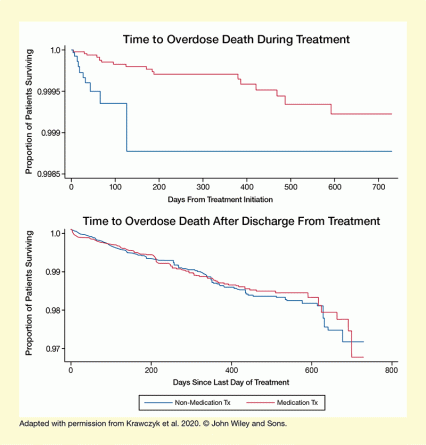This study reported that:

- Among nearly 50,000 adults receiving outpatient treatment for opioid use disorder, fewer overdose deaths occurred among those treated with opioid agonist medications than among those treated with non-medication approaches.
- Risk of overdose death increased after discharge from treatment, and the protective effect of medication treatment versus non-medication treatment was lost.
- Longer time on medication treatment (especially more than 12 months) was associated with a lower risk of overdose death after discharge.
Effective medications are available for treating people with opioid use disorder (OUD). They include the opioid agonist medications methadone and buprenorphine as well as the opioid antagonist naltrexone. Nevertheless, the majority of people in the United States seeking help for OUD only receive counseling, drug testing, peer support, or education.
In a recent NIDA-supported study, Dr. Noa Krawczyk from the NYU Grossman School of Medicine and colleagues from the Johns Hopkins Bloomberg School of Public Health and other partner institutions analyzed treatment data and state death records of patients with OUD in Maryland to demonstrate that those who were treated with agonist medications were less likely to die from an overdose than those who only received non-medication forms of care or support (called “non-medication treatment” for purposes of the study). “This is one of the first state-wide studies in the United States to quantify the significant role that agonist medication treatments play in reducing overdose risk relative to treatments that do not involve medications, which unfortunately continue to be the norm in our country,” says Dr. Krawczyk.
The team analyzed treatment data for 48,274 adults seeking specialty outpatient treatment for OUD from 757 providers in Maryland in 2015 and 2016. They then linked those treatment data to state death records, comparing overdose death rates for patients who received medication treatment with methadone or buprenorphine with those who received non-medication treatment (the study excluded patients receiving naltrexone); both groups were matched for numerous demographic and historical variables. Approximately half of the study population received only medication treatment, 28 percent received only non-medication treatment, and 22 percent received both.
Medication Treatment Has Greater Effect on Overdose Risk During Therapy
A total of 371 overdose deaths occurred during the 2-year study, most of them after patients had been discharged from treatment, and particularly during the first 4 weeks after discharge. During treatment, the risk of overdose death was about five times lower for those who received medication therapy than for those who only received other forms of care and support (see Figure). After treatment discharge, this difference in death rates between both groups disappeared. Moreover, death rates increased for both groups, illustrating the protective effect of receiving any treatment for OUD. The team also found that for patients receiving medication treatment, the risk of overdose death after discharge generally decreased the longer the patient had remained in treatment, especially after 12 or more months. Overall, patients who had received medication treatment remained in treatment much longer than those who had received no medication treatment (248 days versus 22 days).
“I was not surprised to find that medication treatments like methadone and buprenorphine are protective against overdose relative to non-medication treatments, but the difference—with medication treatment five times more protective—was striking,” says Dr. Krawczyk. She adds, “I was also rather surprised (and disappointed) to see that once people are no longer in care, medication has no remaining protective effect. This really drove home the importance of focusing on retention in medication treatment and not only on initial engagement.”
The study had some limitations: It used an observational design and included only patients in publicly funded specialty clinics; it also could not account for additional factors that might have affected overdose death rates, such as differences in service settings, reasons for leaving treatment, ongoing substance use, and switching between providers. In addition, a much higher proportion of the study population (72 percent) received medication treatment than is typical for U.S. patients with OUD. Nevertheless, the study demonstrated that outpatient medication treatment for OUD in community specialty clinics can reduce overdose deaths.
According to Dr. Krawczyk, the study findings have several implications. “From a policy perspective, more needs to be done to encourage and require treatment programs for OUD to offer and prioritize medication treatment, especially programs that serve those least likely to get these medications, such as youth, people experiencing homelessness, and people who are justice involved,” she says. She adds, “But engagement in medication treatment is not enough on its own—we also need to work harder to improve retention in care, by making treatment more welcoming, less burdensome, and more patient-centered.”
This research was supported by NIDA grant DA047021.
- Text Description of Figure
-
The graphs show time to overdose death during and after treatment for OUD. The upper panel illustrates time to overdose death during treatment. The horizontal x-axis shows the days from treatment initiation on a scale from 0 to 700. The vertical y-axis shows the proportion of patients surviving at each timepoint, on a scale from 0.9985 to 1.0. The upper red curve represents the time to overdose death for patients receiving medication treatment; the lower blue curve represents the time to overdose death for patients receiving only non-medication treatment. For patients receiving medication treatment, the proportion of patients surviving declined relatively steadily throughout the period analyzed. For the patients receiving non-medication treatment, the proportion of patients surviving declined steeply until about 120 days after treatment initiation and then remained constant.
The lower panel illustrates time to overdose death after treatment for OUD. The horizontal x-axis shows the days from last day of treatment on a scale from 0 to 800. The vertical y-axis shows the proportion of patients surviving on a scale from 0.97 to 1.0. Again, a red curve indicates time to overdose death for patients receiving medication treatment and a blue curve indicates time to overdose death for patients receiving nonmedication treatment. Both curves overlap and decline moderately until about 600 days after the end of treatment and then drop more steeply.
Source:
- Krawczyk, N., Mojtabai, R., Stuart, E.A., et al. Opioid agonist treatment and fatal overdose risk in a state-wide US population receiving opioid use disorder services. Addiction. 2020;115:1683-1694. doi: 10.1111/add.14991
